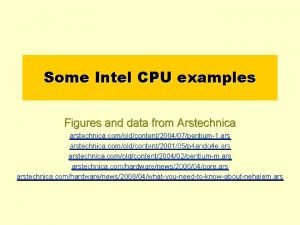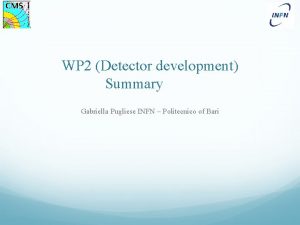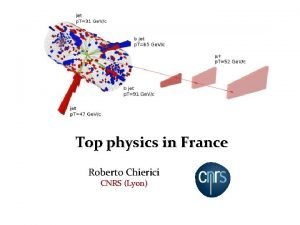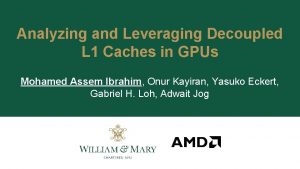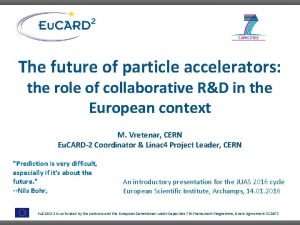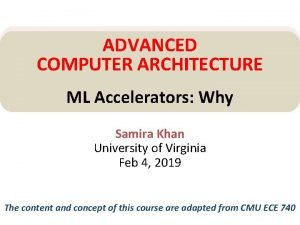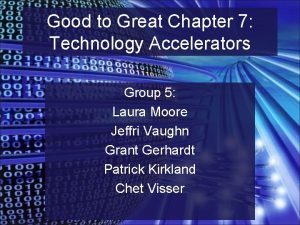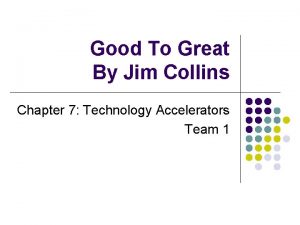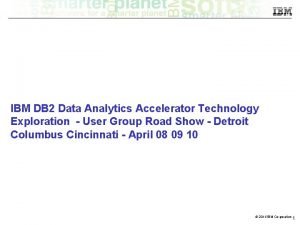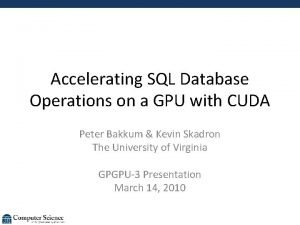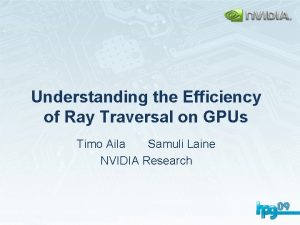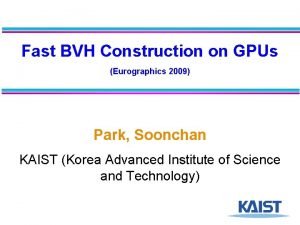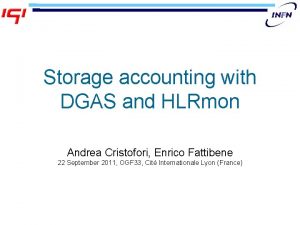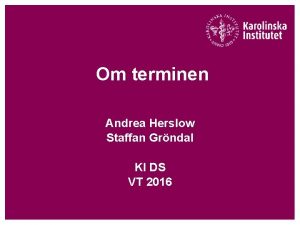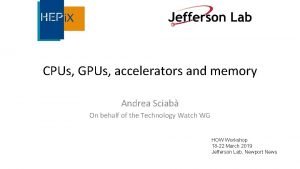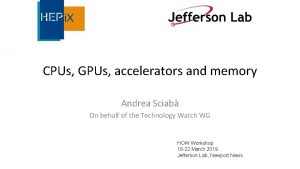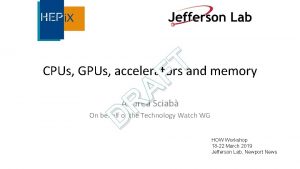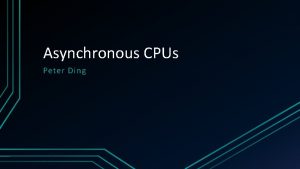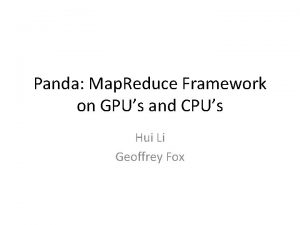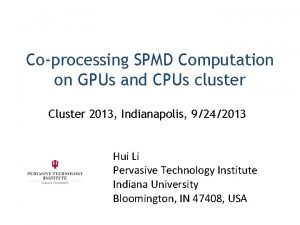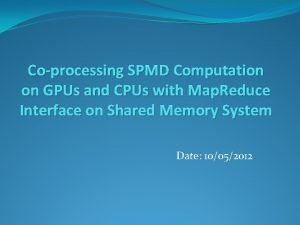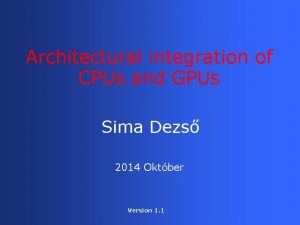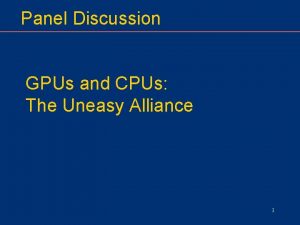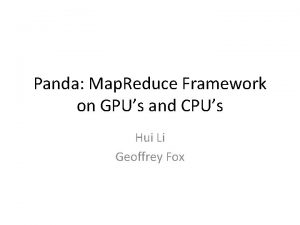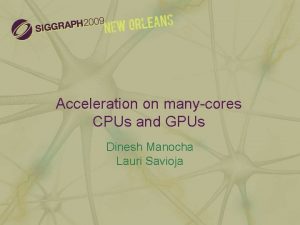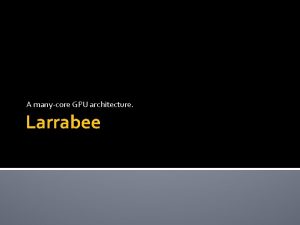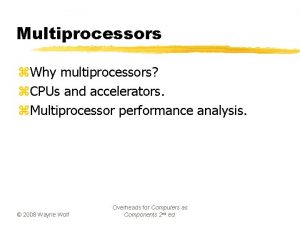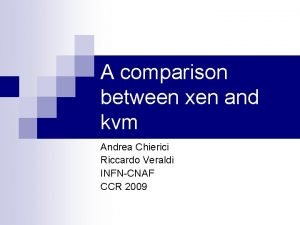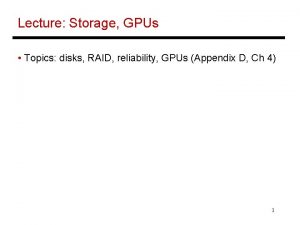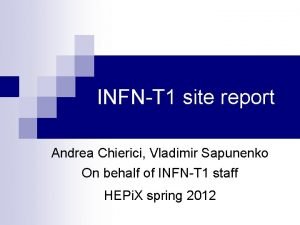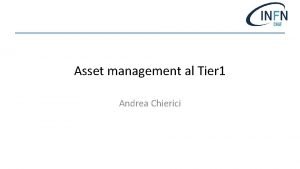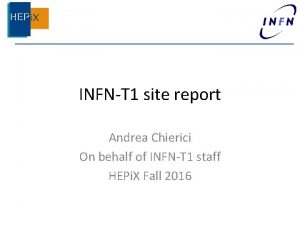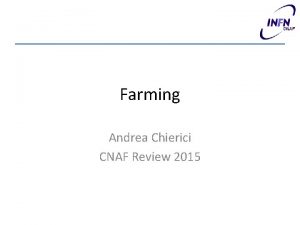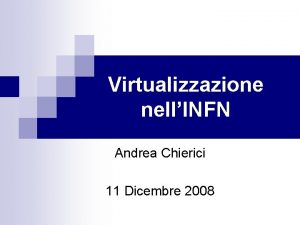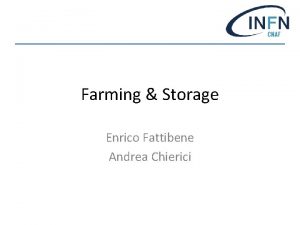CPUs GPUs accelerators and memory Andrea Chierici On






































- Slides: 38

CPUs, GPUs, accelerators and memory Andrea Chierici On behalf of the Technology Watch WG

Introduction • The goal of the presentation is to give a broad overview of the status and prospects of compute technologies – Intentionally, with a HEP computing bias • Focus on processors and accelerators and volatile memory • The wider purpose of the working group is to provide information that can be used to optimize investments – Market trends, price evolution • More detailed information is already available in a document – Soon to be added to the WG website 28/03/2019 2

Outline • • General market trends CPUs and accelerators Memory technologies Supporting technologies 28/03/2019 3

GENERAL MARKET TRENDS 28/03/2019 4

Semiconductor device market and trends • Global demand for semiconductors topped 1 trillion units shipped for the first time • Global semiconductor sales got off to a slow start in 2019, as year-to-year sales decreased • Long-term outlook remains promising, due to the ever-increasing semiconductor content in a range of consumer products • Strongest unit growth rates foreseen for components of – smartphones – automotive electronics systems – devices for deep learning applications 28/03/2019 5

Semiconductor fabrication • Taiwan leading all regions/countries in wafer capacity • TSMC held 67% of Taiwan’s capacity and is leading • Samsung and SK Hynix represent 94% of the installed IC wafer capacity in South Korea – They are likely to influence memory prices (which are now very high) • New manufacturing lines are expected to boost industry capacity by 8% in both 2018 and 2019 28/03/2019 6

Process technology • Performance scaling in process technology continues to grow Moore’s law prediction • Embedded processors benefit the most from process manufacturing improvements • EUV (Extreme Ultra-Violet) is forecast to be the dominant lithography technology in the coming years – Already used for 7 nm by TSMC for AMD, Apple, Nvidia and Qualcomm 28/03/2019 7

Intel and AMD market share • AMD server market share is rapidly increasing since 2017, but from almost nothing – Zen architecture released in 2017 – Achieved 5% of server shipment market share on Q 4 2018, projected to 10% in one year Source: Passmark website (statistics are voluntarily submitted benchmark results) • AMD always had a reasonable (20 -30%) share overall • EPYC revenue was $58 m in the second 2018 quarter vs $36 m in the prior quarter 28/03/2019 8

CPUS AND ACCELERATORS 28/03/2019 10

Intel server CPU line-up • Intel Xeon Scalable Processors – Currently based on Skylake-SP and coming in four flavours, up to 28 cores • Only minor improvements foreseen for 2019 – Adding support for Optane DC Persistent Memory and hardware security patches • New microarchitecture (Sunny Cove) to become available late 2019 – Several improvements benefiting both generic and specialised applications 28/03/2019 11

Current and future Intel server architectures Microarchitecture Technology Launch year Highlights Skylake-SP 14 nm 2017 Improved frontend and execution units More load/store bandwidth Improved hyperthreading AVX-512 Cascade Lake 14 nm++ 2019 Vector Neural Network Instructions (VNNI) to improve inference performance Support 3 D XPoint-based memory modules and Optane DC Security mitigations Cooper Lake 14 nm++ 2020 bfloat 16 (brain floating point format) Sunny Cove (aka Ice Lake) 10 nm+ 2019 Single threaded performance New instructions Improved scalability Larger L 1, L 2, μop caches and 2 nd level TLB More execution ports Willow Cove 10 nm 2020? Cache redesign New transistor optimization Security Features Golden Cove 7/10 nm? 2021? Single threaded performance AI Performance Networking/5 G Performance Security Features 28/03/2019 12

Other Intel x 86 architectures • Xeon Phi – Features 4 -way hyperthreading and AVX-512 support – Elicited a lot of interest in the HEP community and for deep learning applications – Announced to be discontinued in summer 2018 • Networking processors (Xeon D) – So. C design – Used to accelerate networking functionality or to process encrypted data streams – Two families, D-500 for networking and D-100 for higher performance, based on Skylake -SP with on-package chipset – Hewitt Lake just announced, probably based on Cascade Lake • Hybrid CPUs – Will be enabled by Foveros, the 3 D chip stacking technology recently demonstrated 28/03/2019 13

AMD server CPU line-up • EPYC 7000 line-up from 2017 – Resurgence after many years of Bulldozer CPUs thanks to the Zen microarchitecture • +40% in IPC, almost on par with Intel • 2 x power efficiency vs Piledriver – Up to 32 cores • Already being tested and used at some WLCG sites 28/03/2019 14

EPYC Naples • EPYC Naples (Zen) consists of up to 4 separate dies, interconnected via Infinity Fabric – Chiplets allow a significant reduction in cost and higher yield • Main specifications – up to 32 cores – 4 dies per chip (14 nm), each die embedding IO and memory controllers – 2. 0 -3. 1 GHz of base frequency – 8 DDR 4 memory channels with hardware encryption – up to 128 PCI gen 3 lanes per processor (64 in dual) – TDP range: 120 W-200 W • Similar per-core and per-GHz HS 06 performance to Xeon 28/03/2019 15

EPYC Rome • Next AMD EPYC generation (Zen 2), embeds 9 dies, including one for I/O and memory access – Should compete with Ice Lake • Main specs: – 9 dies per chip : a 14 nm single IO/memory die and 8 CPU 7 nm chiplets • +300 -400 MHz for low core count CPUs 8 DDR 4 memory channels, up to 3200 MHz up to 64 cores up to 128 PCI Gen 3/4 lanes per processor TDP range: 120 W-225 W (max 190 W for SP 3 compatibility) Claimed +20% performance per-core over Zen, +75% through the whole chip with similar TDP over Naples – To be released during 2019 – – – 28/03/2019 16

ARM in the data center • ARM is ubiquitous in the mobile and embedded CPU world • Data center implementations have been relatively unsuccessful so far – Performance/power and performance/$ not competitive with Intel and AMD • LHC experiments can use ARM CPUs if needed – Some do nightly build on ARM since years • Only a few implementations (potentially) relevant to the data center – – 28/03/2019 Cavium Thunder. X 2 Fujitsu A 64 FX ARM Neoverse Ampere e. MAG, Graviton 18

Marvell Thunder. X 2 and Fujitsu A 64 FX • Thunder. X 2 for mainstream cloud and HPC data centers, from 2018 – Enjoys the greatest market visibility and reasonable performance/$ • Used e. g. at CRAY XC-50 at Los Alamos and HPE Apollo 70 based Astra HPC system at Sandia National Laboratory – ARM V 8. 1 architecture • Up to 32 cores, 4 -way SMT • Up to 8 DDR 4 memory channels • Up to 56 PCIe Gen 3 lanes • Fujitsu A 64 FX to be used in supercomputer at RIKEN center – Based on the V 8. 2 -A ISA architecture • • First to deliver scalable vector extensions (SVE) 48 cores 32 GB of HBM 2 high bandwidth memory 7 nm Fin. FET process – Interesting to see what performance will achieve as it may lead to a more competitive product 28/03/2019 19

ARM Neoverse • Two platforms for the data center – N 1 for cloud, E 1 for throughput • Based on the Neoverse N 1 CPU – Very similar architecture to Cortex A 76 but optimized for high clock speeds (up to 3. 1 GHz) – Two N 1 cores each with L 1 and L 2 caches – To be combined by licensees with memory controller, interconnect and I/O IP • Demonstrated the N 1 Hyperscale Reference Design – – 64 -128 N 1 CPUs each with 1 MB of private L 2 8 x 8 mesh interconnect with 64 -128 MB of shared cache 128 x PCIe/CCIX lanes 8 x DDR 4 memory channels • Intended to strengthen ARM’s server market share – Not expected to be available for another 1 -1. 5 years 28/03/2019 Source: Anandtech 20

IBM POWER • POWER 9 – – – Used in Summit, the fastest supercomputer 4 GHz Available with 4 -way (up to 24 cores) First supporting PCIe-Gen 4 CAPI 2. 0 I/O to enable • Coherent user-level access to accelerators and I/O devices • Access to advanced memories – NVLink to increase bandwidth to Nvidia GPUs – 14 nm FINFET process – Product line with full support for RHEL/CENTOS 7 • POWER 10 – 10 nm process – Several feature enhancements – First to support PCIe Gen 5 28/03/2019 21

RISC-V and MIPS • RISC-V is an open source ISA – To be used by some companies for controllers (Nvidia and WD), for FPGA (Microsemi), for fitness bands… – For the time being, not targeting the data center – Might compete with ARM in the mid term – Completely eclipsed MIPS • MIPS – Considered dead 28/03/2019 22

Discrete GPUs: current status • GPU’s raw power follows the exponential trend on numbers of transistors and cores • New features appear unexpectedly, driven by market (e. g. tensor cores) – Tensor cores: programmable matrix-multiply-and-accumulate units – Fast half precision multiplication and reduction in full precision – Useful for accelerating deep learning training/inference 28/03/2019 https: //devblogs. nvidia. com/programming-tensor-cores-cuda-9/ 23

Nvidia and AMD • Volta addressing the server market, Turing the gaming market Feature Volta (V 100) Turing (2080 Ti) Process 12 nm CUDA cores yes Tensor cores yes RT cores NA yes FP performance FP 16: 28 TFLOPS FP 32: 14 TFLOPS FP 64: 7 TFLOPS Tensor: 112 TFLOPS Same, but FP 64: 1/32 of FP 32 Memory HBM 2 GDDR 6 Memory bandwidth 900 GB/sec 616 GB/sec Multi-GPU NVLink 2/SLI Applications AI, datacenter, workstation AI, workstation, gaming 28/03/2019 • Vega 20 – Directly aimed at the server world (Instinct MI 50 and MI 60) • Evolution of Vega 10 using a 7 nm process – – more space for HBM 2 memory, up to 32 GB 2 x memory bandwidth Massive FP 64 gains PCIe Gen 4 • Some improvements relevant for inference scenarios – Support for INT 8 and INT 4 data types – Some new instructions 24

GPUs - Programmability • NVIDIA CUDA: – C++ based (supports C++14), de-facto standard – New hardware features available with no delay in the API • Open. CL: – Can execute on CPUs, AMD GPUs and recently Intel FPGAs – Overpromised in the past, with scarce popularity • Compiler directives: Open. MP/Open. ACC – Latest GCC and LLVM include support for CUDA backend • AMD HIP: – Interfaces to both CUDA and AMD MIOpen, still supports only a subset of the CUDA features • GPU-enabled frameworks to hide complexity (Tensorflow) • Issue is performance portability and code duplication 28/03/2019 25

GPUs in LHC experiments software frameworks • Alice, O 2 – Tracking in TPC and ITS – Modern GPU can replace 40 CPU cores • CMS, CMSSW – Demonstrated advantage of heterogeneous reconstruction from RAW to Pixel Vertices at the CMS HLT – ~10 x both in speed-up and energy efficiency wrt full Xeon socket – Plans to run heterogeneous HLT during LHC Run 3 28/03/2019 • LHCb (online - standalone) Allen framework: HLT-1 reduces 5 TB/s input to 130 GB/s: – Track reconstruction, muon-id, two-tracks vertex/mass reconstruction – GPUs can be used to accelerate the entire HLT-1 from RAW data – Events too small, have to be batched: makes the integration in Gaudi difficult • ATLAS – Prototype for HLT track seed-finding, calorimeter topological clustering and antikt jet reconstruction – No plans to deploy this in the trigger for Run 3 26

FPGA • Players: Xilinx (US), Intel (US), Lattice Semiconductor (US), Microsemi (US), and Quick. Logic (US), TSMC (Taiwan), Microchip Technology (US), United Microelectronics (Taiwan), GLOBALFOUNDRIES (US), Achronix (US), and S 2 C Inc. (US) • Market valued at USD 5 Billion in 2016 and expected to be valued at 10 Billion in 2023 • Growing demand for advanced driverassistance systems (ADAS), developments in Io. T and reduction in time-to-market are the key driving factors 20 nm 16 nm 14 nm Intel® Xilinx® Intel® Process Technology Intel® Xilinx® Virtex® Ultra. Scale Top Performance Tier ® Mid Performance Tier Intel® Arria® 10 Low Performance Tier Intel® Cyclone® 10 GX Virtex® Ultra. Scale+® Zynq® Ultra. Scale+® Xilinx® Intel® Stratix® 10 Kintex Ultra. Scale ® Source: https: //www. intel. com/content/www/us/en/programmable/documentation/mtr 1422491996806. html#qom 1512594527835__fn_soc_variab_avail_xlx 28/03/2019 27

FPGA programming • Used as an application acceleration device – Targeted at specific use cases • Neural inference engine • MATLAB • Lab. VIEW FPGA • Open. CL – Very high-level abstraction – Optimized for data parallelism • C / C++ / System C – High level synthesis (HLS) – Control with compiler switches and configurations • In HEP – High Level Triggers • https: //cds. cern. ch/record/2647951 – Deep Neural Networks • https: //arxiv. org/abs/1804. 06913 • https: //indico. cern. ch/event/703881/ – High Throughput Data Processing • https: //indico. cern. ch/event/669298/ • VHDL / Verilog – Low level programming 28/03/2019 28

MEMORY TECHNOLOGIES 28/03/2019 30

Static RAM (SRAM) • On die memory on the CPU used for L 1/L 2/L 3 cache – SRAM cell size not scaling with node • SRAM cache constitutes large fraction of area on modern CPUs • Power consumption is an issue • Applications driving larger caches • No direct replacement in sight for L 1/L 2 • Alternate L 3 cache technologies – e. DRAM - Used in IBM Power CPUs – STT-MRAM - proposed as possible replacement 28/03/2019 https: //www. sigarch. org/whats-the-future-of-technology-scaling/ 31

Dynamic RAM (DRAM) • Dominant standards continue to evolve – DDR 4 -> DDR 5 • 3200 MT/s -> 6400 MT/s • 16 Gb -> 32 Gb chips – GDDR 5 - > GDDR 5 X • 14 Gbps/pin -> 16 Gbps/pin • 8 Gb -> 16 Gb chips – HBM -> HBM 2 • 1 Gbps/pin -> 2. 4 Gbps/pin • 4 die stack -> 12 die stack • 2 Gb die -> 8 Gb die • Note memory latency remains mostly unchanged 28/03/2019 (Youngwoo Kim, KAIST’s Terabyte Labs) https: //www. 3 dincites. com/2019/02/designcon-2019 -shows-board-and-system-designersthe-benefits-of-advanced-ic-packaging/ 32

DRAM Outlook • Major vendors showing next generation chips (DDR 5/GDDR 6) • Multiple technologies being investigated for future DRAM • EUV lithography not needed for at least 3 more generations (Micron) • Contract DRAM pricing fell ~30% in Q 1 2019 • Pressure expected on DRAM prices thru 2019 due to additional production capacity coming online https: //www. techinsights. com/technology-intelligence/overview/technology-roadmaps/ 28/03/2019 33

Emerging technologies • May eventually fill the gap – STT-MRAM between SRAM and DRAM (work in progress) – “Persistent Memory” in NVDIMM package for the DRAM/NAND gap • Low latency NAND (e. g. Z-NAND) • 3 D XPoint (aka “Optane”) – Technologies still in the lab • • • 28/03/2019 MRAM NRAM Fe. RAM PCRAM Re. RAM https: //www. snia. org/sites/default/files/PMSummit/2018/presentations/14_PM_Summit_18_Analysts_Session_Oros_Final_Post_UPD ATED_R 2. pdf 35

SUPPORTING TECHNOLOGIES 28/03/2019 36

Interconnect technology • Increasing requirements on bandwidth and latency driving the development – E. g. moving data between CPU and GPU is often a bottleneck – Several standards competing (PCIe Gen 4/5, CCIX, Gen-Z, Open. CAPI, CXL…) • Proprietary technologies – NVLink (GPU-to-GPU, GPU-to-POWER 9) – Ultra Path (Intel), CPU-to-CPU – Infinity Fabric (AMD), chiplet-to-chiplet 28/03/2019 37

Packaging technology • Traditionally a silicon die is individually packaged, but more and more CPUs package together more (sometimes different) dies • Classified according to how dies are arranged and connected – 2 D packaging (e. g. AMD EPYC): multiple dies on a substrate – 2. 5 D packaging (e. g. Intel Kaby Lake-G, CPU+GPU): interposer between die and substrate for higher speed – Intel Foveros, a 2. 5 D with an interposer with active logic (Intel “Lake Field” hybrid CPU) – 3 D packaging (e. g. stacked DRAM in HBM), for lower power, higher bandwidth and smaller footprint • Can alleviate scaling issues with monolithic CPU dies but at a cost, both financial and in power and latency 28/03/2019 38

What next? • We do not really know what will be there in the HL-LHC era (2026 -2037) • Some “early indicators” of what might come next – Several nanoelectronics projects might help in • Increasing density of memory chips • Reducing size of transistors in IC – Nanocrystals, silicon nanophotonics, carbon nanotubes, single-atom thick graphene film, etc. – https: //www. understandingnano. com/nanotechnology-electronics. html 28/03/2019 39

Conclusions • Market trends – Server market is increasing, AMD share as well – EUV lithography driving 7 nm mass production • CPU, GPUs and accelerators – – AMD EPYC promising from a cost perspective Nvidia GPUs still dominant due to the better software support Recent developments for GPUs greatly favor inference workloads FPGA market dominated by telecom, industry and automotive but there is also some HEP usage • Memory technologies – SDRAM still the on-chip memory of choice, DRAM still for the main memory, no improvements in latency – NVDIMM – emerging memory packaging for memory between DRAM and NAND flash (see next talk) – Other non-volatile memory technologies in development 28/03/2019 40

Additional resources • All subgroups – https: //gitlab. cern. ch/hepix-techwatch-wg • CPUs, GPUs and accelerators – Document (link) • Memory technologies – Document (link) 28/03/2019 41

Acknowledgments • Special thanks to Shigeki Misawa, Servesh Muralidharan, Peter Wegner, Eric Yen, Andrea Sciaba’, Chris Hollowell, Charles Leggett, Michele Michelotto, Niko Neufeld, Harvey Newman, Felice Pantaleo, Bernd Panzer-Steindel, Mattieu Puel and Tristan Suerink 28/03/2019 42
 Which function is incorporated into some intel cpus
Which function is incorporated into some intel cpus Gabriella chierici wikipedia
Gabriella chierici wikipedia Roberto chierici
Roberto chierici Analyzing and leveraging decoupled l1 caches in gpus
Analyzing and leveraging decoupled l1 caches in gpus The long-term future of particle accelerators
The long-term future of particle accelerators Accelerators computer architecture
Accelerators computer architecture Kotter 8 accelerators
Kotter 8 accelerators Good to great technology accelerators
Good to great technology accelerators Good to great chapter 7
Good to great chapter 7 Cosmic super accelerators
Cosmic super accelerators Analytics query accelerators
Analytics query accelerators Sql on gpus
Sql on gpus Understanding the efficiency of ray traversal on gpus
Understanding the efficiency of ray traversal on gpus Fast bvh construction on gpus
Fast bvh construction on gpus Internal memory and external memory
Internal memory and external memory Primary memory and secondary memory
Primary memory and secondary memory Virtual memory
Virtual memory Semantic memory example
Semantic memory example Explicit and implicit memory
Explicit and implicit memory Long term memory vs short term memory
Long term memory vs short term memory Logical memory vs physical memory
Logical memory vs physical memory Which memory is the actual working memory?
Which memory is the actual working memory? Virtual memory in memory hierarchy consists of
Virtual memory in memory hierarchy consists of Eidetic memory vs iconic memory
Eidetic memory vs iconic memory Symmetric shared memory architecture
Symmetric shared memory architecture Alexia my weird school
Alexia my weird school Andrea j. goldsmith
Andrea j. goldsmith Andrea beyer cleveland clinic
Andrea beyer cleveland clinic Andrea slan
Andrea slan Andrea danyluk
Andrea danyluk Andrea cristofori
Andrea cristofori Andrea motto
Andrea motto Dr andrea tamm
Dr andrea tamm Andrea ramos desnuda
Andrea ramos desnuda Andrea pavleka
Andrea pavleka Andrea krabbe
Andrea krabbe Dr fodor andrea
Dr fodor andrea Andrea herslow
Andrea herslow Andrea garca
Andrea garca
